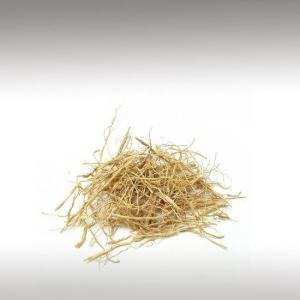
VETIVER ESSENTIAL OIL (VETIVERIA ZIZANIOIDES) - ESSENTIAL OILS

BASE / GENERAL DATA
Information submited: February 20, 2015 Modified: March 27, 2018 By: OperaDreamhouse
Botanical Name: Chrysopogon zizanioides
Common Method of Extraction: Steam distillation
Part Typically Used: Root
Color: Amber brown
Consistency: Thick
Perfumery Note: Base
Strength of Initial Aroma: Aroma is very earthy, deep, sweet, woody, smoky, amber, and balsam.
Chrysopogon Zizanioides, commonly known as Vetiver is a perennial grass of the Poaceae family, native to India.
Vetiver can grow up to 1,5 metres high and form clumps as wide. The stems are tall and the leaves are long, thin, and rather rigid, the flowers are brownish-purple. Unlike most grasses, which form horizontally spreading, mat-like root systems, Vetiver's roots grow downward, 2 - 4 m in depth. Vetiver has no stolons nor rhizomes. Because of all these characteristics, the Vetiver plant is highly drought-tolerant and can help to protect soil against sheet erosion. In case of sediment deposition, new roots can grow out of buried nodes.
Vetiver is most closely related to Sorghum but shares many morphological characteristics with other fragrant grasses, such as Lemongrass (Cymbopogon Citratus), Citronella (Cymbopogon Nardus), and Palmarosa (Cymbopogon Martinii).
Though it originates in India, vetiver is widely cultivated in the tropical regions of the world. The world's major producers include Haiti, India, Java, and Réunion. Vetiver comes from a Tamil name meaning "Hatcheted up".
Vetiver is mainly cultivated for the fragrant essential oildistilled from its roots. In perfumery, the older French spelling, Vetyver, is often used. Another major operation in the field is the one owned by the Boucard family. Réunion is considered to produce the highest quality Vetiver essential oil called "Bourbon Vetiver" with the next favorable being Haiti and then Java.
The best quality oil is obtained from 18 - 24 - month - old roots. The roots are dug up, cleaned, and then dried. Before the distillation, the roots are chopped and soaked in water. The distillation process can take up to 24 hours. After the distillate separates into the essential oiland hydrosol, the oil is skimmed off and allowed to age for a few months to allow some undesirable notes forming during the distillation to dissipate.
The oil distilled in Haiti and Réunion has a more floral quality and is considered of higher quality than the oil from Java, which has a smokier scent. In the north of India, oil is distilled from wild-growing Vetiver. This oil is known as "Khus" or "Khas", and in India is considered superior to the oil obtained from the cultivated Variety. It is rarely found in commerce outside of India, as most of it is consumed within the country.
Like Patchouli and Sandalwood essential oils, the odor of Vetiver develops and improves with aging.
Common Method of Extraction: Steam distillation
Part Typically Used: Root
Color: Amber brown
Consistency: Thick
Perfumery Note: Base
Strength of Initial Aroma: Aroma is very earthy, deep, sweet, woody, smoky, amber, and balsam.
Chrysopogon Zizanioides, commonly known as Vetiver is a perennial grass of the Poaceae family, native to India.
Vetiver can grow up to 1,5 metres high and form clumps as wide. The stems are tall and the leaves are long, thin, and rather rigid, the flowers are brownish-purple. Unlike most grasses, which form horizontally spreading, mat-like root systems, Vetiver's roots grow downward, 2 - 4 m in depth. Vetiver has no stolons nor rhizomes. Because of all these characteristics, the Vetiver plant is highly drought-tolerant and can help to protect soil against sheet erosion. In case of sediment deposition, new roots can grow out of buried nodes.
Vetiver is most closely related to Sorghum but shares many morphological characteristics with other fragrant grasses, such as Lemongrass (Cymbopogon Citratus), Citronella (Cymbopogon Nardus), and Palmarosa (Cymbopogon Martinii).
Though it originates in India, vetiver is widely cultivated in the tropical regions of the world. The world's major producers include Haiti, India, Java, and Réunion. Vetiver comes from a Tamil name meaning "Hatcheted up".
Vetiver is mainly cultivated for the fragrant essential oildistilled from its roots. In perfumery, the older French spelling, Vetyver, is often used. Another major operation in the field is the one owned by the Boucard family. Réunion is considered to produce the highest quality Vetiver essential oil called "Bourbon Vetiver" with the next favorable being Haiti and then Java.
The best quality oil is obtained from 18 - 24 - month - old roots. The roots are dug up, cleaned, and then dried. Before the distillation, the roots are chopped and soaked in water. The distillation process can take up to 24 hours. After the distillate separates into the essential oiland hydrosol, the oil is skimmed off and allowed to age for a few months to allow some undesirable notes forming during the distillation to dissipate.
The oil distilled in Haiti and Réunion has a more floral quality and is considered of higher quality than the oil from Java, which has a smokier scent. In the north of India, oil is distilled from wild-growing Vetiver. This oil is known as "Khus" or "Khas", and in India is considered superior to the oil obtained from the cultivated Variety. It is rarely found in commerce outside of India, as most of it is consumed within the country.
Like Patchouli and Sandalwood essential oils, the odor of Vetiver develops and improves with aging.

SPIRITUAL PRACTISES DATA

MEDICINE / HEALTH DATA

BEAUTY / COSMETICS DATA

FOOD / COOKING DATA
COMMENTS
No comments.
Newest mixtures containing Vetiver Essential Oil (Vetiveria Zizanioides):

Essential Oil for the First Chakra (The Root Chakra - Muladhara)
February 23, 2015


